Peer-to-peer fundraising isn’t always limited to an online fundraising campaign. Sometimes, nonprofits get creative with peer-to-peer fundraising events; effectively raising money and engaging supporters at the same time.
Let’s talk about some of the ways you can use peer-to-peer events to fuel your nonprofit fundraising.
The Lowdown On Peer-to-Peer Fundraising Events
Peer-to-peer events are a form of peer-to-peer fundraising, a technique that uses the influence of your supporters to raise money for your cause.
Although this type of fundraising historically occurs in-person, technology has enabled nonprofits to bring peer-to-peer online, in a sense broadening a campaign’s exposure.
Peer-to-peer events usually have online and offline components, with fundraisers raising money from friends, family, and coworkers virtually, followed by an in-person event.
Common peer-to-peer events include:
- Marathons/5Ks/Fun Runs/Obstacle Races
- DIY events in celebration of a birthday, anniversary, wedding, baby shower, etc.
- Sport-related activities such as a bowl-a-thon, golf-a-thon, or workout class
- Symbolic gestures and challenges such as a fast or shaving one’s head
- Memorial campaigns that honors an individual or pays tribute to beloved pet
Why Run A Peer-to-Peer Fundraising Event?
These fundraisers are so appealing because they don’t just raise money for your organization; they also help you inspire, activate, and rally your supporters to get involved on a deeper level.
Through an event, supporters learn more about your cause, share their knowledge with others, and actively participate to show their commitment.
It’s not uncommon for supporters to get involved with the same peer-to-peer event year after year. Therefore, there seems to be a connection between retention and peer-to-peer events worth exploring.
What’s the first step to getting started?
If you haven’t organized a peer-to-peer event in the past, there’s no time like the present to try it out.
Check out our online guide Peer-to-Peer Fundraising: Everything You Need to Know. Then, follow the eleven tips listed below to fine-tune your strategy.
11 Tips for Coordinating a Successful Peer-to-Peer Fundraising Event From Real Experienced Fundraisers
1. Educate Your Fundraisers
Your personal fundraisers (that’s what we call the supporters who actively fundraise online for your cause) are doctors, lawyers, teachers, students, parents, and even sometimes children.
Most of them aren’t trained fundraisers, so it’s vital that your nonprofit provides adequate training and support to guide them on their fundraising journey.
Education comes in many forms. You can create a personal fundraiser toolkit with vital information on the campaign, instructions for setting up the fundraising website, and marketing tips.
You can also provide one-on-one training, or designate a support point-person. Any way you cut it, your fundraisers won’t be successful without the right education.
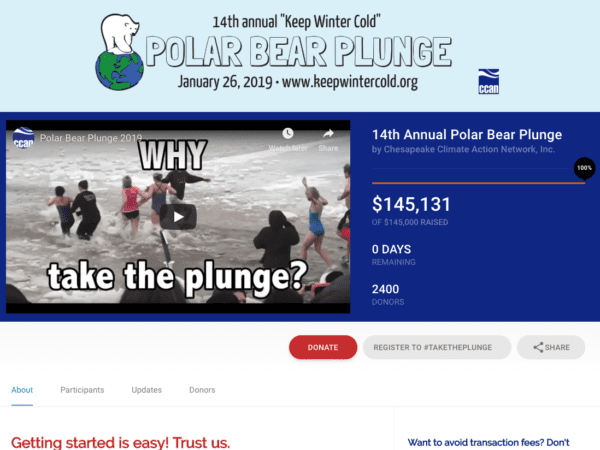
Kelly McLaughlin from the Chesapeake Climate Action Network told us, “I think our main takeaway is that when it comes to [online fundraising], you have two options to expand. You can either recruit more fundraisers, OR you can empower the fundraisers you have to raise more money.”
2. Encourage Storytelling
“People can relate to a story or cause in different ways, so we empower people to share their own story about why they get involved.” Mackenzie Delmotte, N Street Village.
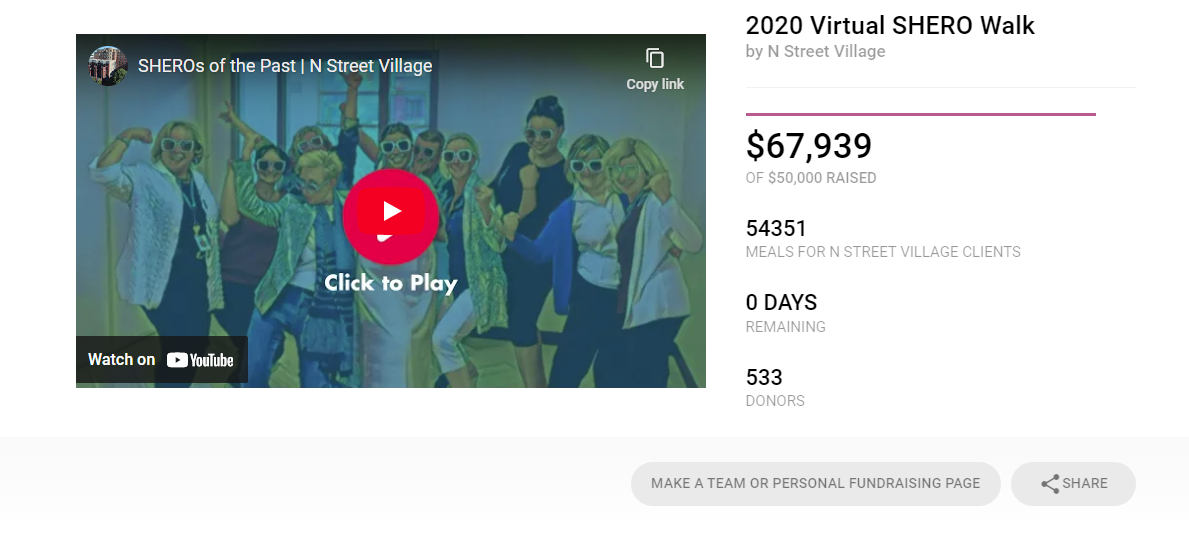
Stories fuel giving. Chances are, your nonprofit has controlled your story narrative for the most part.
You share client testimonials, show inspirational videos, and take pictures from work in the field. But guess what? Your personal fundraisers have stories of their own; stories that relate directly to your organization’s work.
Encourage storytelling by providing sample stories for personal fundraisers to review and give them prompts to help them tell their own. For inspiration, check out: The Ultimate Guide to Storytelling for Personal Fundraisers.
3. Promote The Event Early On
Treat your peer-to-peer event as you would any other fundraising activity.
This means planning and promoting ahead of time. Have your website, event details, logistics, and personal fundraiser resources ironed out and ready to go 4-6 weeks before kickoff. Recruit your personal fundraisers 2-4 weeks out. And aim to start your campaign with some money in the pot (that’s when donors like your board of directors are key).
Market your event through all your normal channels: email, social media, in-person asks, direct mail, and phone calls– catering your message and request to each segmented supporter. Know who your target personal fundraiser is versus who you think may be a great event sponsor.
“Learn how to get the word out.” Move beyond saying who your organization is and what you do. Instead, cater each message to the recipient,” notes Lauren Melzer Of Junior Achievement of Greater Washington
4. Use Integrations
Nonprofits use a variety of software programs any given day in addition to your online fundraising software. As you’re managing participants, processing donations, and compiling data, remember to use the integrations available through your platform to make your job easier.
For example, CauseVox uses Zapier to streamline processes and improve data collection. CauseVox + Zapier allows nonprofits like Amigos de Las Americas to import vital data from the CauseVox peer-to-peer fundraising platform to over 750 applications.
“The CauseVox integration with Zapier makes this process easy for us on the peer-to-peer side of things. We integrated everything in house and relatively quickly,” said April Hearn of Amigos.
5. Try Custom Fields
Are you providing participants t-shirts? Do you need them to sign a liability waiver? Does your organization prefer to use donation tiers? Custom fields allow your nonprofit to collect the data you need to run your peer-to-peer event seamlessly.
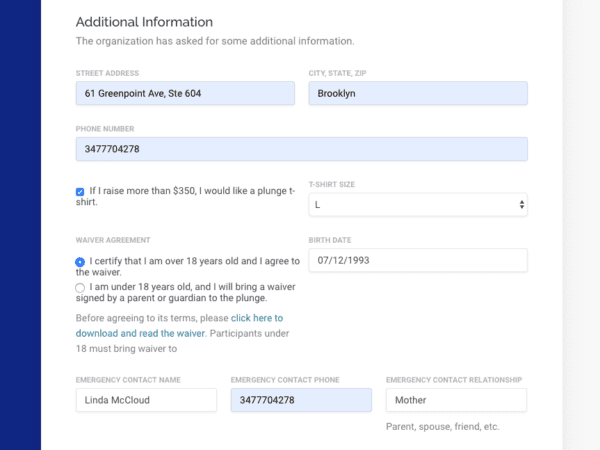
The Chesapeake Climate Action Network relied on CauseVox’s custom fields to capture the information they needed for their annual Polar Bear Plunge event. Some of the fields included t-shirt sizes, waiver “signatures,” and contact information. “We learned retroactively that we had to fine-tune our custom fields,” she explained, but she was able to do so effortlessly.
Pro Tip: To avoid form fatigue and overwhelming potential donors with too many questions, we recommend getting the necessary information – name, billing and payment info – to process a gift and thank your donor. If you want to include custom fields, limit it to one or two questions.
6. Enable The Impact Meter
“People want to see that their donation made an impact for the entire campaign,” said Makenzie Delmotte, Events Manager at N Street Village.
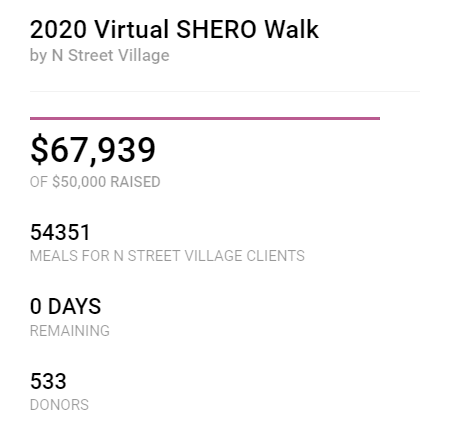
There’s no better way to see the immediate impact of a donation than through an impact meter, like N Street Village did here by showing the number of meals donations provided.
These handy tools located directly on your nonprofit and personal fundraisers’ fundraising websites track the campaign’s progress and intended impact in real time. Donors on the fence about giving may be more inclined to give if they see what their gift is poised to do.
7. Keep An Eye On Your Fundraising Thermometer
Along the same vein as an impact meter, don’t discount a fundraising thermometer that showcases real-time fundraising progress. Fundraising thermometers are the most basic form of gamification (taking elements of game play and integrating those elements into non-game scenarios such as fundraising). It creates a sense of competition and can help ramp up engagement (and donations!).
Pro Tip: To make your peer-to-peer event extra engaging, you can throw leaderboards, point systems, or badges into the mix.
8. Replicate From Previous Years (Or In The Future)
Once you run one peer-to-peer event, don’t forget to replicate your campaign. This simple set saves you time, and allows you to fine-tune your processes from one event to the next.
“It was easy to replicate our event in the second year, copying most of the content while having the ability to make any needed changes.” David Cohn, First Tee of Southeast Wisconsin.
9. Ask For Help
“Being a fairly complex campaign, the ability to reach CauseVox to discuss our personal needs, and see them delivered, timely and effectively, has been a major relief on our end,” mentions Lauren Melzer of Junior Achievement of Greater Washington.
As you navigate the world of online peer-to-peer events, remember that we’re here to help.
Typical fundraising software is clunky, complex, and contract-bound, but CauseVox actually tidies up your digital fundraising. Run your peer-to-peer fundraising event in less time, without hassle.
We’ve put together everything you need to be a fundraising powerhouse — from our award-winning knowledge library to our suite of easy-to-use tools, to our experienced hands-on support team who believe in you and root for you.
10. Communicate Regularly
Be sure to communicate with your fundraisers on a regular basis. This can include thanking your supporters, sharing positive encouragement, and just generally checking in to see how they’re doing.
Depending on your fundraiser’s communication preferences, you can text, email, or DM them. Surveys and feedback forms also work great to gauge how your fundraisers are doing and create buy-in.
11. Find The Right Platform for Your Peer-to-Peer Fundraising Event
The easiest and most effective way to organize a peer-to-peer event is with an online fundraising platform.
These tools provide a variety of features to help a nonprofit reach an expansive online audience with the help of personal fundraisers. There are standard features to look for when choosing the right platform.
These include:
- Capacity for peer-to-peer and team fundraising
- Personalizable websites
- Custom input fields
- Integrations with other software
- Desktop and mobile-friendly
- Strong customer support
- Adequate space for storytelling
- Cost-effective
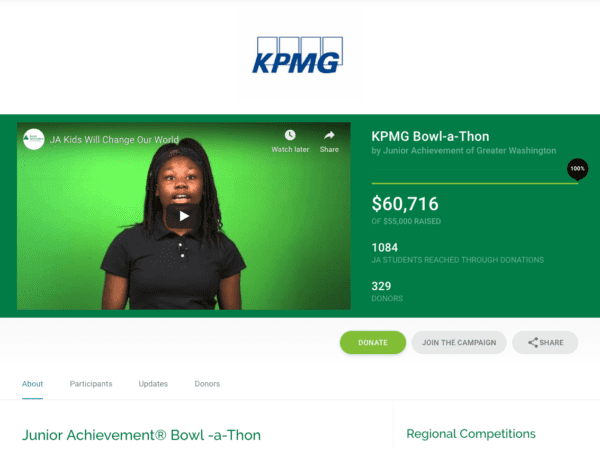
Junior Achievement of Greater Washington chose CauseVox to power their large-scale peer-to-peer events.
According to Lauren Meltzer, “We needed to find a platform which would be user-friendly, have an attention-drawing look and feel, and that would help Junior Achievement to maximize our fundraising dollars – all while making each Bowl-a-Thon a successful, fun event for our participants.”
Peer-to-Peer Fundraising: Frequently Asked Questions
How Does Peer-to-Peer Fundraising Work?
Peer-to-Peer fundraising is a powerful strategy that uses competition and social proof to quickly and effectively raise funds for any cause. With peer-to-peer fundraising, individuals fundraise on behalf of your cause by sharing their own personalized campaign pages with their networks.
To better understand how peer-to-peer fundraising works, let’s dive into the anatomy of a peer-to-peer fundraising campaign. There’s generally three components:
- Event Campaign Page – this is the main landing page of your peer-to-peer fundraising campaign that your org sets up with a progress bar and general info/instructions.
- Team Page – a team page is for a group of people who’ve decided to team up to hit a specified goal
- Personal Page – within a team page, each individual will have a personal fundraising page.
Note: People don’t necessarily have to join a team, they can always decide to set a goal for themselves and raise money on their own. For these individuals, they will have a personal page that isn’t linked to a team page.
After you’ve set up a main campaign event page (complete with your organization’s logo, branding, and an attention-grabbing appeal), your supporters then create and customize their own team or personal fundraising pages. After setting their own fundraising goal, donations that trickle in are counted towards their team or personal goal while rolling into your overall peer-to-peer fundraising campaign goal.
With any successful peer-to-peer fundraiser, you’re going to need a team of eager and passionate supporters. These individuals can be existing donors, board members, advocates, and volunteers.
As your supporters raise money on your behalf, it’s important to keep the momentum going by posting updates, showing gratitude, and maybe even introducing some friendly competition. After all, peer-to-peer fundraising is supposed to be fun!
What Are The Benefits of Peer-to-Peer Fundraising?
There are many benefits to peer-to-peer fundraising that when combined together are hard to beat. By relying on the fundraising efforts of your existing supporters, peer-to-peer fundraising:
- Strengthens existing relationships with your top supporters
- Raises funds quickly and reliably
- Boosts donor acquisition and retention
- Increase awareness and visibility to your cause to new networks
- Reallocates staff effort and time to other pressing tasks by empowering others
- Costs less compared to traditional fundraising methods
What Is The Difference Between Peer-to-Peer Fundraising And Crowdfunding?
While you might be thinking that peer-to-peer fundraising sounds a lot like crowdfunding, there are some fundamental differences.
Sure, both peer-to-peer fundraising and crowdfunding tap into an individual’s personal and professional networks as a means to raise money, but peer-to-peer fundraising is more decentralized. With crowdfunding, donations flow into a single campaign page while peer-to-peer fundraising relies on individuals to share personalized campaign pages.
Another difference between the two is that peer-to-peers tend to be hosted by organizations as they require more resources. Crowdfunding can also be set up by an organization but it’s common to see crowdfunding campaigns started by individuals to raise money for a specific, personal cause such as a medical expense or creative endeavor.
Whether your organization is better suited to run a peer-to-peer fundraising campaign or a crowdfunder will depend on who is fundraising and the purpose of the project.
Using Software To Manage Your Peer-to-Peer Fundraising Event
For any peer-to-peer fundraising event to be successful, you not only need a group of dedicated supporters but you’re going to needthe right software. We’re not going to lie – there’s a lot out there to choose from, but here’s where CauseVox can help you raise more with less effort – especially when you’re running a high volume campaign.
Efficiently Track Donation Data
With CauseVox, data from your peer-to-peer campaign is tracked and organized in an administrative dashboard. Not only are you able to track donations made online but you can add offline donations to your campaign total.
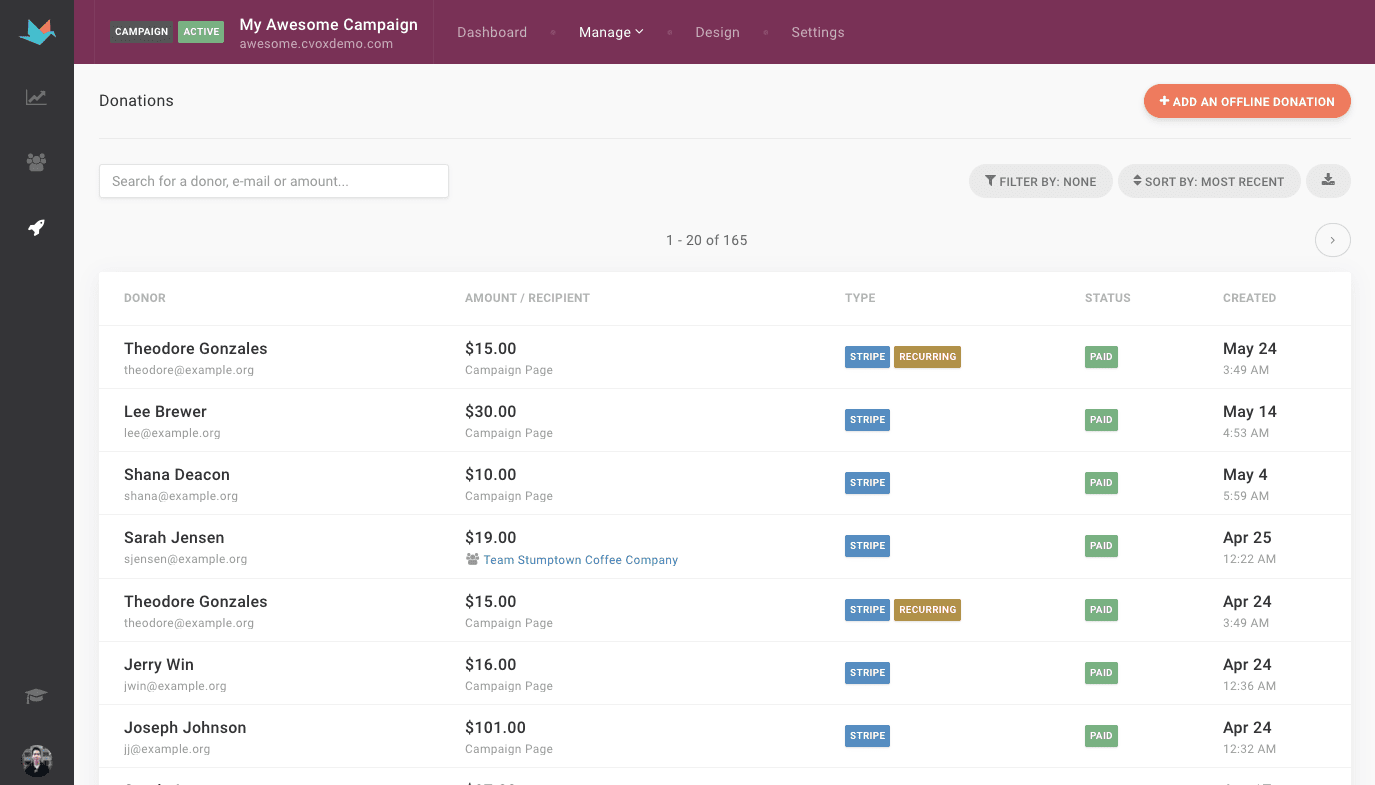
We’ve also made it easy to manage fundraising pages so you can see how much each page has raised at a glance.
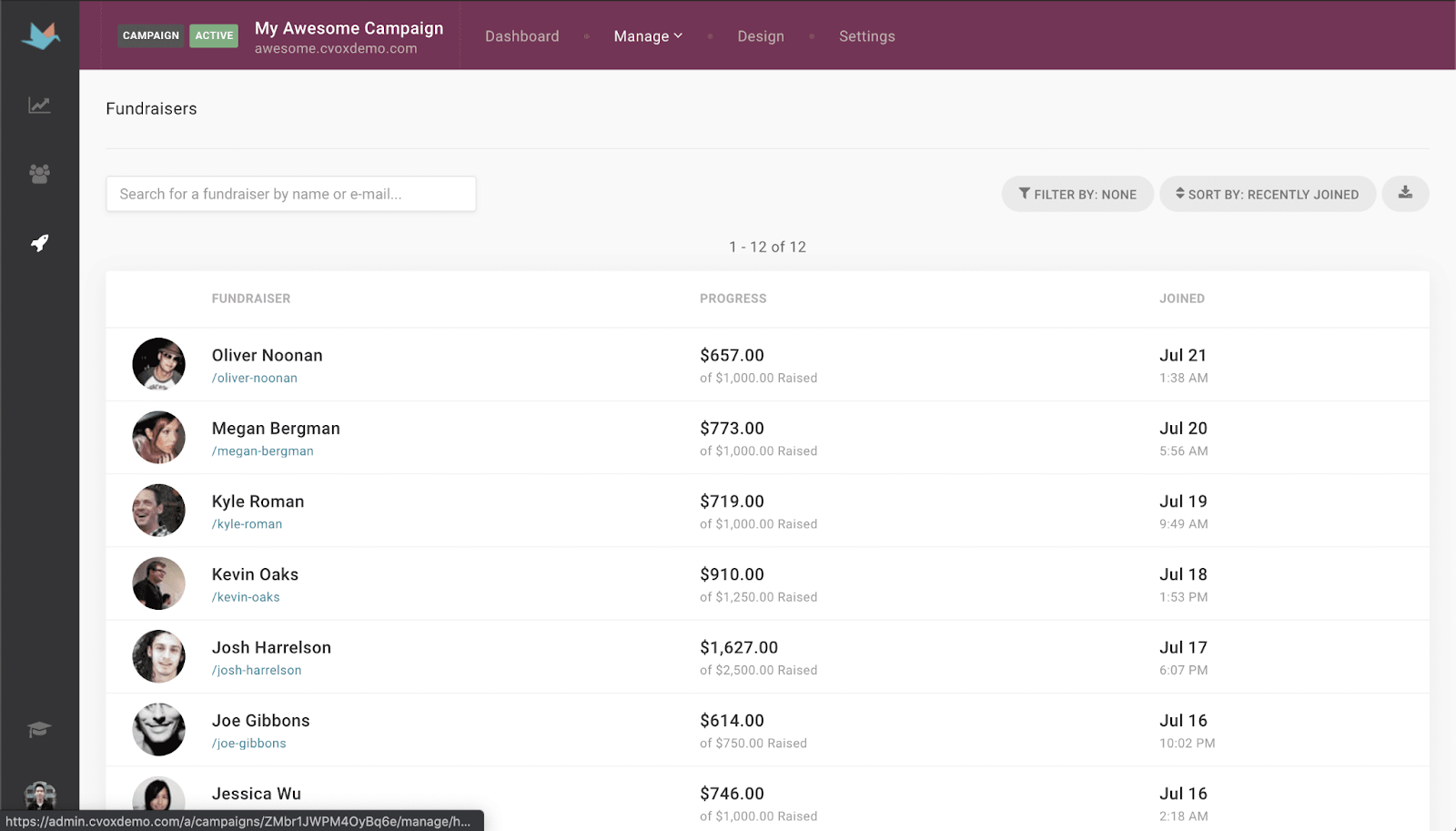
Measure Important Metrics
CauseVox also lets you effortlessly track the KPIs that matter. From tracking your progress towards your overall fundraising goal to displaying an impact metric so that your audience understands the value of their dollar, CauseVox does it all. Need to set up and track an activity metric? We’ve got you covered.
Customize the Fundraiser Experience
No two peer-to-peer fundraising events are alike which is why being able to customize the fundraiser experience is crucial. The ideal fundraising platform should allow anyoneto edit their campaign – no design or coding experience required.
Using CauseVox, your fundraiser can create a branded page within minutes that can be used right out of the box or personalized with testimonials, images, and more. It really depends on how involved they want to be.
Easily Share Your Campaign Page
With social sharing, your participants can easily share their campaign page across a swath of popular social channels including Facebook, Twitter, LinkedIn, and more!
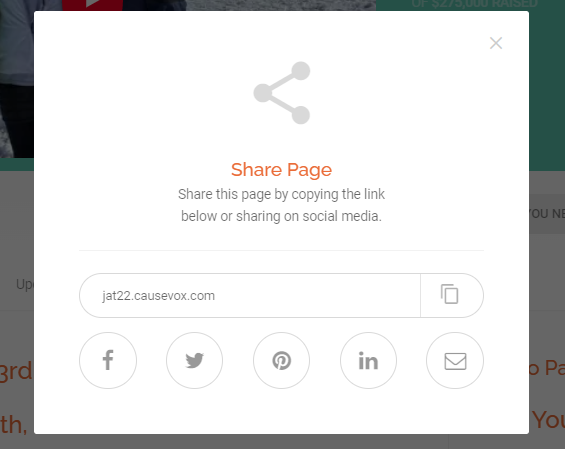
Integrate With Other Platforms
Another plus with CauseVox is that you can instantly integrate with other fundraising tools you use everyday. Our software can connect with 1500+ applications and platforms including Salesforce, MailChimp, Kindful, and more so that you can automate manual, time-consuming back-office tasks.
What Are You Waiting For?
Thousands of organizations from small local charities to global national nonprofits trust and use CauseVox.
Starting for free today and schedule a demo of CauseVox to see for yourself how you can raise more with less effort.




